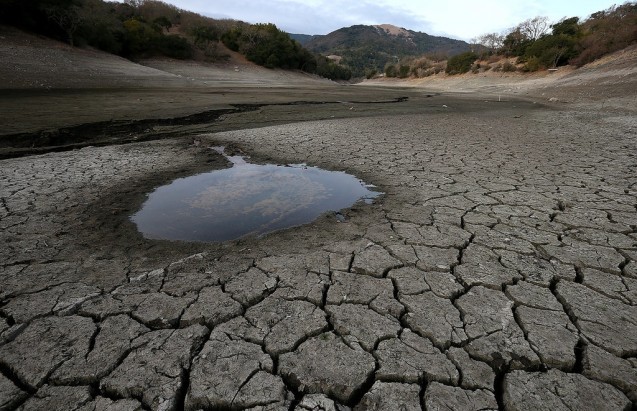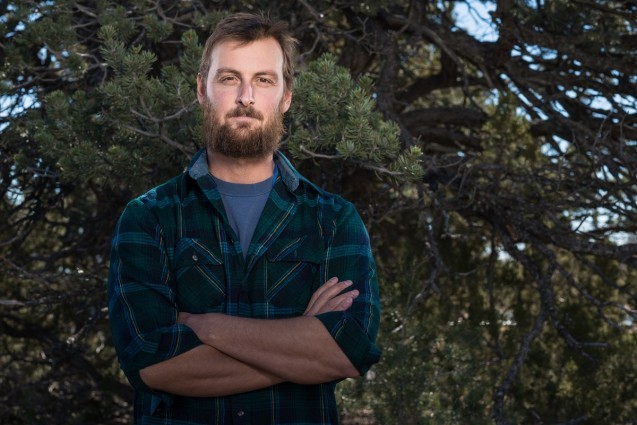Q&A: Park Williams on Drought, Climate and ‘Cracking the Code’
“Future extremes are going to occur more and more frequently. In planning, we don’t need to plan for the 2 degree warming that we are aiming for as a globe, we need to plan for the 10 degree increase in a day, or the year when there’s no water. We need to plan for worst-case scenarios.”

By Federico Sendel
Park Williams, 34, and a California native, is a bioclimatologist at Columbia University’s Lamont-Doherty Earth Observatory. He is lead author on a recently published paper linking the California drought to global warming. The study looked at what percentage of the drought has been caused by human-induced climate change, and what percentage is due to natural climate variability.
Williams’ work focuses on climate variability and climate change’s impact on the living world. Federico Sendel, a student in the Earth Institute’s MS in Sustainability Management program, spoke with Williams about his background and his work (before the latest paper came out).
Can you talk about your conclusions in that paper on the California drought?
Williams: We find that this drought, like any drought, is primarily caused by natural climate variability. But, the drought is worse because of global warming. Warming causes the atmosphere’s ability to take water out of ecosystems to go up. The last four years of drought in California can be blamed about 15 percent on human-induced global warming, and the other 85 percent is due to natural variability.
Tell me a bit about your upbringing. Did growing up in California influence your decision to study drought in the state?
I grew up in northern California next to Folsom Lake, which is now commonly used in pictures to illustrate the severity of the current drought. When I was in elementary school in the late 1980s, California experienced a long drought event that seems to barely remain in California’s memory, but I remember that Folsom Lake was just about as dry during that drought as it is now. It was probably that event that initially piqued my interest in California drought.
On a larger scale, my family went on a lot of road trips all over the western United States when I was a kid. The first trip was when I was in third grade. We drove across the Sierra Nevadas in California, the Great Basin of Nevada and Utah, the Colorado Rockies, and the Sonora and Mojave Deserts. I was fascinated by the variability among these landscapes. Much of that variability (such as differences in vegetation) is due to differences in climate and resultant differences in water availability.
So, yes, my interests in the causes and consequences of drought were definitely fueled by my personal experiences as a kid.

In terms of climate change, do you think that drought is one of the most immediate and pressing impacts?
I think so, although it’s not all that straightforward. As the globe gets warmer, then the atmosphere can hold more water vapor. When this happens, there’s more water available for rain. So there are some areas that are going to get wetter. Even in dry areas or places that will get drier because of warming, when it rains, it might rain harder, since there’s more water in the atmosphere.
I imagine that this variability is a challenge for you then. If a place gets a long period of higher precipitation, people might question the drought warnings.
Yes. I’d say southwestern North America is probably a really good example of that. They tend to have a lot of low-frequency variability in their rainfall, meaning that if it’s wet, it’s generally wet for a decade or more. If it’s dry, it’s usually dry for a decade or more. Now, the Southwest may have just finished what was a 16-year dry period, where everybody in the Southwest was thinking, “Oh my God, climate change is awful. It’s made it so dry and hot here.” But if we switch into a more El Niño type of climate for the next several years, then the southwest is going to get very wet, and suddenly there’s going to be a lot of water that was not available before.
This will also impact human societies. People will then begin to relapse and not need to be as conservative with water, and maybe some cities will continue growing in places where they shouldn’t. And then in the 2030s, when it gets very dry and warm again, it will be warmer than it was in the last drought, then you have a situation on your hands.
Has public awareness of climate change had a noticeable impact on your work, positive or negative?
There’s a little bit of both. On the positive side, when I started working on this stuff in the early 2000s, I don’t think the idea of global warming was recognized by the general public. Some people knew, but it was definitely not a mainstream concept.
The downside has been pretty strong, though. As more and more people have learned about global warming, the issue has become increasingly politicized. It’s very hard to be immune to that. It is almost as if you can accurately predict somebody’s opinion about global warming based purely on which political party they align with. And that’s too bad, because it’s alienating many of us.
The research is obviously very important, and we need a lot of people working on it, but it’s becoming increasingly difficult to do the research, because the political situation has made it tougher to be funded. There are people in government who don’t want to see this research done, and they have actively eliminated funding from us. They even take pride in cutting earth science budgets, it’s something to brag about. Unfortunately, it’s borderline corruption to do that. It’s really maddening.
In your own research, are there any results that have particularly surprised you?
Yes. I was doing a study last year; I was studying fog in southern California. In California’s coast, every summer it’s foggy. They call it the “June Gloom.” A lot of people don’t like that fog, but it’s very important to ecosystems, and it’s also very important to controlling temperature along the coast. In my study, I was trying to figure out what causes some summers to be very foggy and others to be very clear. The goal was to try to understand how climate change might affect the fog and in turn might affect future climate in cities like Los Angeles. What I ended up finding was that even though there are large scale climatological drivers that do cause variability in fogginess year to year, by far the most dominant thing occurring in the Los Angeles area was reductions in fog because of urban warming, also known as the heat-island effect.
What is the most satisfying part of your work?
Selfishly, I really like cracking the code on things. I really love trying to figure something out in a data set and spending months or years trying to figure it out, and then getting it. I really enjoy that part. More broadly, I really enjoy communicating about science. Even though it’s hard work, I like giving talks to universities, speaking at scientific conferences or to the public.
What about the most frustrating part of your work?
Money. The money is the most frustrating part. It feels as though what we do is very expensive because money is so tough to come by. I almost feel bad asking the government for my salary when I have a good idea. … It turns out that what is actually spent on environmental research is far cheaper than a lot of other things we spend money on. It’s really disheartening to oftentimes feel from our government like what we do isn’t worth it, even though we are so cheap.
In your bio, you state that your ultimate goal is “to advance scientific knowledge in ways relevant and interesting to the public and policy makers.” If you could deliver a single message to policy makers and the public (related to your work), what would you say?
Resilience. In planning for the future. We know that there are many aspects of climate that will be unfamiliar to us, meaning that records will be broken in all kinds of things: rainfall, temperature, lake levels, stream flow, snow packs. None of these changes are going to occur all that gradually.
Future extremes are going to occur more and more frequently. In planning, we don’t need to plan for the 2 degree warming that we are aiming for as a globe, we need to plan for the 10 degree increase in a day, or the year when there’s no water. We need to plan for worst-case scenarios. These scenarios may only occur once in the next century, but in many cases that’s all it takes.
The Paris Climate Conference is coming up. There seems to be a general sense of optimism around the conference and the results that will be achieved. What do you think?
You know, it’s not my area of expertise at all. I do admit that I’ve grown fairly pessimistic by these conferences because the leading countries refuse to commit. We do have a president who says we need to commit, but we as a country really haven’t done a whole lot. We’ve been using more and more renewable energy. But that’s not because of global treaties; it’s because of the open market. If I were a betting man, I’d say that once again, this conference is going to be a lot of talk and in the end, no real guarantee that we are going to see global action.
Watch an interview with Williams on the news site Democracy Now (starts at 30:30 into the broadcast).
